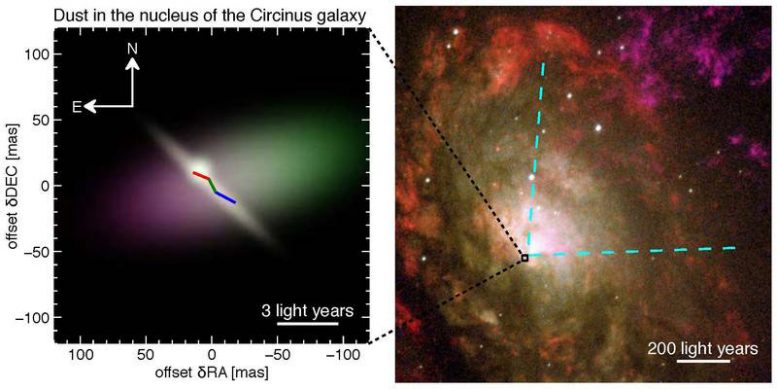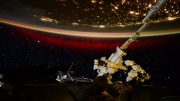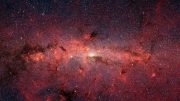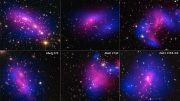
At the heart of the Circinus galaxy. The right image shows the inner 1000 light-years of the Circinus galaxy. Blinding light and gaseous material are ejected by the active nucleus (located in the black box). They escape only along a conical region towards the northwest (upper right part of the image), leading to the white V-shaped structure in this image. Along other directions, the nuclear region is hidden by dense gas and dust. This obscuring dust has now been investigated with unprecedented detail with the Very Large Telescope Interferometer. The false-color model image on the left shows the dust emission and corresponds to the region marked by the black box in the right image. The emission comes from a relatively thin, disk-like structure (white) as well as dust elongated perpendicular to it. The disk is also seen by water emission (red-green-blue line). The dust emission is more absorbed towards the southeast (bottom left) than the northwest (top right), illustrated by the change from violet to green colors. Credit: Left: Konrad Tristram; Right: NASA HST, News Release STScI-2000-37
An international team of astronomers has viewed a dense disk and a bright funnel at the center of the Circinus galaxy.
A research team led by Konrad Tristram from the Max Planck Institute for Radio Astronomy in Bonn, Germany, obtained the most detailed view so far of the warm dust in the environment of a supermassive black hole in an active galaxy. The observations of the Circinus galaxy show, for the first time, that the dust directly illuminated by the central engine of the active galaxy is located in two distinct components: an inner warped disk and a surrounding larger distribution of dust. Most likely, the larger component is responsible for most of the obscuration of the inner regions close to the supermassive black hole.
In active galactic nuclei, enormous amounts of energy are released due to the feeding of the supermassive black hole in the center of the galaxy. Such black holes have masses of a million or billion times the mass of the sun. The matter spiraling in onto the black hole becomes so hot and luminous that it outshines its entire galaxy with billions of stars. The huge amounts of energy released also affect the surrounding galaxy. Active galactic nuclei are therefore thought to play an important role in the formation and evolution of galaxies and hence in the formation of the universe as presently seen.
Using the MIDI instrument at the Very Large Telescope Interferometer of the European Southern Observatory (ESO) in the Atacama Desert of Chile, the research team obtained an unprecedented clear view of the warm dust in the nucleus of the Circinus galaxy. At a distance of only 13 million light years, the Circinus galaxy contains one of the closest and brightest active galactic nuclei.
“We obtained at least twice the amount of interferometric data than for any other galaxy”, proudly reports Konrad Tristram from the Max-Planck-Institute for Radio Astronomy (MPIfR), the lead author of the paper. “Our observations make the Circinus Galaxy by far the best observed extragalactic source in optical and infrared interferometry.” By combining the light of two telescopes, the interferometric observations increase the resolution to that of a telescope of 92 meters in diameter.
In the case of the Circinus Galaxy, the scientists could, for the first time, show that the emission of the nuclear dust comes from two distinct components, an inner disk-like component and an extended component significantly elongated in polar direction. The dust disk in the Circinus Galaxy has a size of about 3 light-years and agrees well with a warped molecular disk revealed by water emission.
This inner disk is surrounded by a much bigger dust distribution with a size of at least 6 light years. We only see the inner edge of this dust distribution, which is directly illuminated by the radiation coming from the central region. This inner funnel appears elongated in polar direction. Its southeastern side is significantly more obscured by dust than the northwestern side. This leads to the observed strong asymmetry and color change in the observed emission.
“From this, we deduce that it is the larger dust component, which is responsible for hiding the central engine and for collimating the visible ionization cone”, explains Leonard Burtscher from the Max-Planck-Institute for Extraterrestrial Physics in Garching. “We can only see the inner, directly illuminated edges of that component. This is certainly in contrast to some earlier speculations.”
There appear to be two types of active galactic nuclei: one where we have a direct view of the inner part of the nucleus with the accretion disk where the energy is released (the “central engine”) and one where the inner part appears to be hidden. This dichotomy has been explained by a doughnut-shaped distribution of dense gas and dust surrounding the central part of the active nucleus, the so-called “torus”. If observed face-on, we can directly see the central engine through the hole in the torus, while if observed edge-on, the material of the torus obscures the view to the center. The torus is also thought to play an important role in feeding the supermassive black hole, providing the material that will ultimately be swallowed. Trying to understand how the torus works is therefore important for understanding active galactic nuclei and their impact in general.
Although there is now a much clearer picture of a torus than before, there are some puzzles remaining: For example, both the dust disk and the polar dust have a temperature of about 300K (~30°C, i.e. about room temperature). Surprisingly, there is no evidence for hotter dust towards the center as would be expected for a centrally heated dust distribution.
“The presence of both a bright disk-like component and a more extended polar dust component at a similar temperature were not predicted by the present models of active galactic nuclei”, concludes Gerd Weigelt, director at the MPIfR and head of the research group for infrared astronomy. “We need new models and new VLTI observations with the upcoming MATISSE instrument to improve our understanding of the three-dimensional dust distribution in the nuclei of active galaxies.”
Reference: “The dusty torus in the Circinus galaxy: a dense disk and the torus funnel” by Konrad R. W. Tristram, Leonard Burtscher, Walter Jaffe, Klaus Meisenheimer, Sebastian F. Hönig, Makoto Kishimoto, Marc Schartmann and Gerd Weigelt, 13 March 2014, Astronomy & Astrophysics.
DOI: 10.1051/0004-6361/201322698
arXiv:1312.4534









Be the first to comment on "Astronomers View Dense Disk and Bright Funnel at the Center of the Circinus Galaxy"